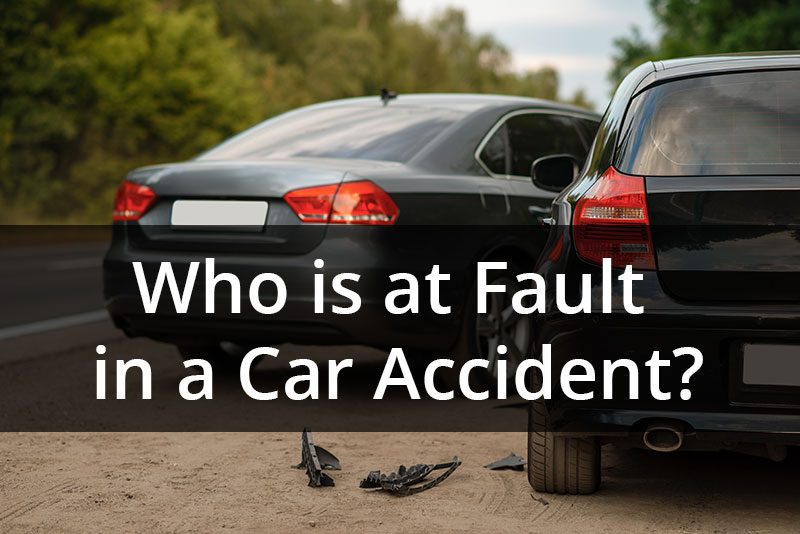Who is at fault in a car accident? When you’ve just been in a collision, that might not be your first concern.
However, when it comes time for the police and insurance to get involved, there’s no doubt you will want to know who is at fault.
Indeed, you will have to know.
This article will outline how to tell who is at fault in a car accident—and who determines that part.
We will also discuss how car insurance companies proceed with accident claims depending on who is at fault and the role of the police in everything.
It is crucial to know as much as you can about liability and how it is determined. It will make the claiming and recovery process much easier for you.
What is an “At Fault Accident”?
An at-fault car accident is one where you hold some or all of the legal responsibility for causing the accident. Determining who is at fault in a car accident is not always straightforward.Â
In some cases, it’s clear: if a driver has run a red light and the other has not, then the one who ran the light is at fault. Similarly, if you’ve rear-ended someone, you are at fault for that collision.
However, in other cases, it’s more complicated.
If you’re speeding and hit someone who did not signal a lane change, then your insurance adjuster may determine that you’re both at fault. How adjusters determine who is at fault in a car accident depends on state laws. One driver, in this case, might be more at fault, but both drivers will carry some responsibility for what happened.
Who Determines Who Is At Fault in a Car Accident?
Many people and parties help determine the responsible driver in an auto collision.
You and the other driver (or drivers) will play an important role, as you know what you were doing when the impact occurred. Both of you, if you are able, should take photographs of the scene. Be aware also of traffic lights and signs that might further indicate who violated the law. Being courteous and respectful toward the other driver (or drivers) is essential while collecting evidence.
Moreover, witnesses at the scene are vital for helping to determine fault.
Going back to the merging example above, you might not have noticed that the other driver did not signal their lane change. However, other people on the road may have seen it. They will prove helpful to you in gathering your evidence.
The police are also going to be useful here.
After all, the officers can test for things like blood alcohol levels and other intoxication types—matters you might suspect but can’t prove definitively by yourself. They will also be able to file an official report regarding the accident, which is crucial in determining fault.
We have a guide to what to do after a car accident if it’s not your fault. Even if you do end up being at fault, follow this guide carefully.
When you have accumulated all of your evidence, you then submit it to your insurance company. It is them who will ultimately determine who is at fault in a car accident.
How Does Car Insurance Decide Who is At Fault?
When you’ve compiled all of your evidence and gotten the police report proving your lack of guilt, it might seem as though your insurance company’s decision will be obvious. Unfortunately, though, your adjuster’s conclusions are not necessarily going to follow the path of logic you and the authorities have been following.
Let’s say, for instance, that someone rear-ended you.
Typically, the fault would lie with the driver who rear-ended you. However, if you were, say, speeding and failed to signal a lane change, your insurance adjuster might decide to assign most of the fault to you.
For another example of how fault and liability might not always be straightforward, consider, “I Was Hit Backing Out of a Parking Space. Who Is at Fault?” Sometimes, if one driver has done something “more” illegal than the other, that first driver could be deemed more liable than the other.
Again, though, this is not guaranteed. Your adjuster will weigh all of the evidence available and make a decision based on that.
Does Insurance Pay If You Are At Fault in an Accident?
What happens if you are at fault in a car accident depends on state legislation. In no-fault states, where personal injury protection is mandatory as part of one’s auto insurance coverage, your insurance will cover you for injuries incurred regardless of liability. Outside of these states, consult a personal injury lawyer for your recourse options.
Whether or not you get compensated for vehicular damage depends on state legislation and your level of fault.
In pure comparative negligence states, your coverage amount depends on the other driver’s level of fault. In a 50/50 at-fault accident, their insurance would cover 50% of your costs and vice versa.
In modified comparative negligence states, your insurance will not pay you out if you are mostly at fault for an accident. For example, if you are 51% responsible for the collision, you will most likely not get any compensation.
Then, in contributory or pure negligence states, you will not receive any compensation if you are at all at fault.
What happens if both drivers are at fault in an accident depends on state laws and each driver’s specific level of responsibility.
In a Three Car Accident, Who Is At Fault?
In such a collision, insurance companies determine fault along the same lines as a two-vehicle accident.
Do Police Reports Say Who Is At Fault?
Police reports can certainly indicate who’s at fault. However, as we’ve seen, they are not the one-and-only deciding factor.
Is the first party named in a police accident report at fault?
Again, not necessarily.
The police can do everything they want to attempt to assign fault. However, as far as insurance companies are concerned, the police report is just one piece of evidence (albeit a compelling one).
How To Prove You Are Not At Fault in an Auto Accident
If you’ve been in a vehicle collision, you will want to prove you are not at fault—or, if your state uses a comparative negligence law, that you are not mostly at fault. Your biggest ally in proving yourself will be the police report. Your own, the other driver’s (or drivers’), and eyewitness evidence will also be beneficial.
“What if the at-fault driver won’t contact the insurance company?” We discuss your options more in that article.
When in doubt, contact a car accident lawyer.
Contact Stoy Law Group Following Your Vehicle Accident
Overall, determining who is at fault in a car accident is paramount to ensuring your auto insurance claim is successful. It isn’t always easy to figure it out, and it’s not always a black-and-white matter.
However, it is crucial to figure out the amount of responsibility you bear, especially if you live in a pure comparative negligence state.
Make sure that you gather as much information as you can from the scene as possible. The reports of witnesses, police, and the other drivers involved will help your insurance adjuster determine who is at fault and whether or not you get any compensation.
If you need help in proceeding with your claim, regardless of how at-fault you may be, we at Stoy Law Group are available to assist you.
You can submit a free case evaluation online. You can also get in touch via our online contact form or by calling (817) 820-0100.














